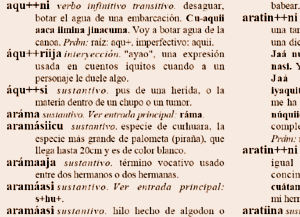Iquito–Castellano and Castellano–Iquito Dictionary

Landing page image for the collection “Iquito–Castellano and Castellano–Iquito Dictionary”. Click on image to access collection.
| Language | Iquito |
| Depositor | Christine Beier, Nora England, Lev Michael |
| Affiliation | University of Texas at Austin |
| Location | Peru |
| Collection ID | 0030 |
| Grant ID | MDP0042 |
| Funding Body | ELDP |
| Collection Status | Collection online |
| Landing Page Handle | http://hdl.handle.net/2196/8d541e5d-6c9a-4f68-b2b9-da7a3aec604c |
Group represented
As of 2006, Iquito was spoken fluently by 25 people in the two small communities of San Antonio de Pintuyacu and Atalaya de Chambira, in the departamento of Loreto, in the northern Peruvian Amazon basin. The youngest fluent speaker is 53 years old and the majority of speakers are 60 to 75 years old. These individuals learned Iquito as their first language and learned Spanish later in their childhood or adulthood. In addition, there are approximately 50 semi-speakers and passive speakers, who range from 25 to 55 years old. Fluent speakers of Iquito are not literate in Spanish or Iquito. No one is functionally literate in Iquito due to the dearth of written materials, but young people are literate in Spanish.
The total population of ethnically Iquito individuals is approximately 500, and the principal language of communication in the Iquito communities is Spanish. Use of Iquito is restricted to occasional private conversations between speakers, with the exception of its use in language revitalization activities.
In the last decade, a strong and widespread language revitalization movement has emerged among the Iquito people in response to the imperiled state of their heritage language. In the past five years, the community has made important strides towards setting up a long-term, effective language revitalization program.
Language information
Documented language is IQU Iquito; translation language is (SPA) Loreto dialect of Peruvian Castellano/Spanish.
Special characteristics
The importance of documenting Iquito rests not only on its degree of endangerment, but also on the dearth of documentation on related languages. Of the seven languages that once comprised the Zaparoan language family (Andoa, Arabela, Aushiri, Cahuarano, Iquito, Omurano, and Záparo – following Wise 1999), only three have remaining speakers (Arabela with 75-100, Iquito with 25, and Záparo with 3-5).
Diversity within the Zaparoan family is substantial, with estimates of the family’s time depth given by Kaufmann (1990) as 41 centuries. There is substantial disagreement among experts concerning the membership and structure of this family (compare Campbell 1997, Kaufmann 1990, Stark 1990). Some
scholars have suggested links between the Zaparoan family and the Peba-Yaguan family (Payne 1984),
and to Taushiro and Candoshi (Kaufman 1994).
Collection contents
This collection consists of a bilingual dictionary from Iquito (as spoken in Loreto, Perú) to local Spanish, and from Spanish and local Spanish to Iquito.
The dictionary was produced using Shoebox 5.0, exported to MSWord using MDF, then converted to PDF. The dictionary is open to users and the Shoebox source files are downloadable with permission.
Collection history
The Iquito Language Documentation Project (ILDP) continues the documentation of Iquito, a highly
endangered language spoken in the Peruvian Amazon. It also implements an innovative model for language documentation in indigenous communities that relies principally on graduate students and
community members to carry out linguistic documentation. The project encompasses thirteen months of active field research which carried out over four years (June 15, 2003 – December 15, 2006).
The result of this project was a bilingual Iquito-Spanish dictionary. This dictionary is based on the knowledge of language consultants Jaime Pacaya Inuma, Hermenegildo Díaz Cuyasa, Ligia Inuma Inuma, and Ema Llona Yareja; it was edited by Lev Michael, Christine Beier, and Karina Sullón Acosta.In addition, the project will train a team of Iquito community members as linguists so they can carry out long-term language documentation to augment the results of this project.
Other information
In the dictionary, the characters + and ++ represent short and long ‘barred i’ respectively; high central unrounded vowels.
Acknowledgement and citation
To refer to any data from the collection, please cite as follows:
Beier, Christine (Depositor). 2006. Iquito–Castellano and Castellano–Iquito Dictionary. Endangered Languages Archive. Handle: http://hdl.handle.net/2196/00-0000-0000-0001-3C3E-E. Accessed on [insert date here].


